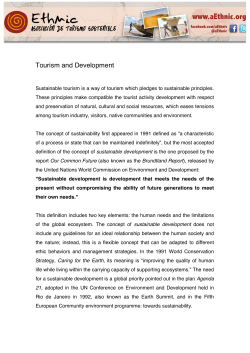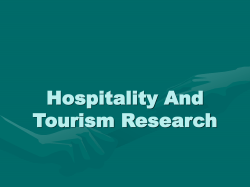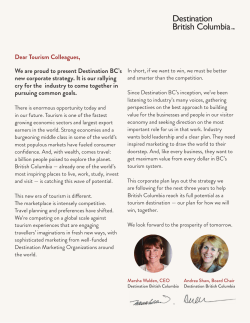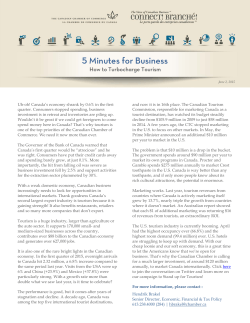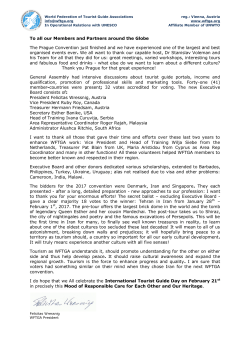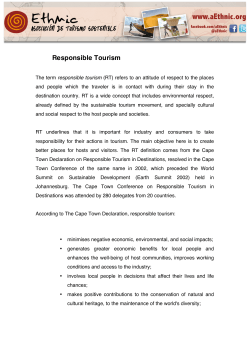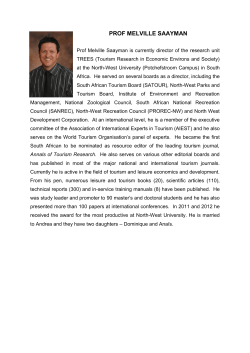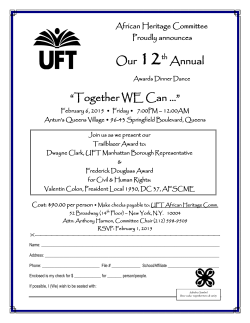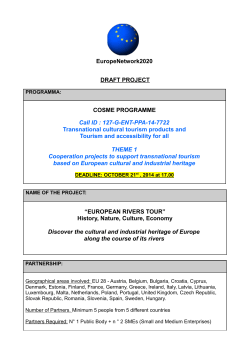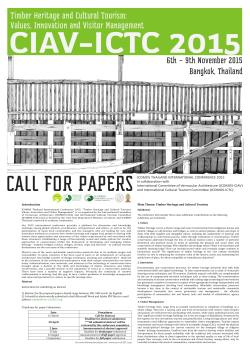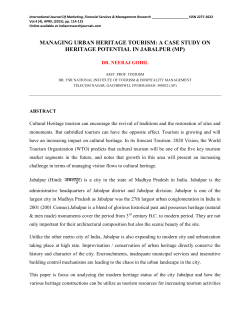
Glossary - European Institute of Cultural Routes
Cultural Routes of the Council of Europe - Glossary Below is a collection of terms linked to Cultural Routes of the Council of Europe. The glossary is taken from the book “Cultural Routes management: from theory to practice” (Council of Europe Publishing, 2015 - , ISBN 978-92-871-7691-2). Please contact us to add other useful terms to the list. Accommodation capacity The capacity that a given destination has to accommodate tourists. This capacity is generally counted by numbers of beds. Acculturation Process implying the assimilation of a foreign culture by a group of individuals. This happens when two cultures come into contact, for example, in the case of tourism. Alternative Tourism Refers to a type of tourism which seeks to differentiate itself from destinations or itineraries attracting mass tourism. Arrivals Number of people registered in hotel establishments during a determined period and in a determined area. Assessment An umbrella term for description, analysis and evaluation. Authenticity Describes the relative integrity of a place, an object or an activity in relation to its original creation. In the context of living cultural practices, the context of authenticity responds to the evolution of the traditional practice. In the context of a historical place or object, authenticity can encompass the accuracy or extent of its reconstruction to a known earlier state. Carrying Capacity Index In the natural sciences this represents the maximum level of polluting substances that an ecosystem is able to absorb without endangering its capacity to regenerate. In a socio-cultural tourism context, it defines the number of tourists that a community can host without compromising its environmental, social and cultural resources. Cultural Mediator A profession consisting in organising and implementing cultural activities by means of temporary or permanent exhibitions or other art collections. The cultural mediator attempts to arouse the interest of the public in heritage by means of workshops, educational activities or by distributing informative publications. Cultural Heritage An expression of the ways of living developed by a community and passed on from generation to generation, including customs, practices, places, objects, artistic expressions and values. Cultural heritage is often expressed as either intangible or tangible cultural heritage. 1 Cultural Landscapes Describes those places and landscapes that have been shaped or influenced by human occupation. They include agricultural systems, modified landscapes, patterns of settlement and human activity, and the infrastructure of production, transportation and communication. The concepts of cultural landscapes can be useful in understanding patterns of activity as diverse as industrial systems, defensive sites and the nature of towns or villages. Cultural Resources Encompasses all the tangible and intangible heritage and living cultural elements of a community. Cultural Route of the Council of Europe A cultural, educational heritage and tourism co-operation project aiming at the development and promotion of an itinerary or a series of itineraries based on a historic route, a cultural concept, figure or phenomenon with a transnational importance and significance for the understanding and respect of common European values (Council of Europe, Annexe Resolution CM/Res(2013)66). Cultural Tourism Essentially a form of tourism that focuses on the culture, and cultural environments, including the landscapes of the destination, and the values and lifestyles, heritage, visual and performing arts, industries, traditions and leisure pursuits of the local population and host community. It can include attendance at cultural events, visits to museums and heritage places, and mixing with local people. It should not be regarded as a definable niche within the broad range of tourism activities, but encompasses all experiences absorbed by the visitor to a place that is beyond their own living environment). Culture Can be defined as the whole complex of distinctive spiritual, material, intellectual and emotional features that characterise a community, society or social group. It includes not only arts and literature, but also modes of life, the fundamental rights of the human being, value systems, traditions and beliefs. Culture encompasses the living or contemporary characteristics and values of a community as well as those that have survived from the past (ICOMOS/ICTC 2002). DMO Acronym for Destination Management Organisation, which is composed of a number of tourist destination management organisations or private and public associates. Effect The terms “effect” and “impact” as referred to in the CD 97/11 are used as terms with similar meaning. Both terms are only important in relation to significance, that is, significant effect or significant impact. GIS Acronym for Geographical Information System, which is an information system capable of organising and presenting alphanumeric and spatial reference data, as well as producing maps and plans. Heritage A broad concept that encompasses our natural, indigenous and historic or cultural inheritance. Heritage Place A site or area of heritage significance that contains a number of buildings and structures, cultural landscapes, monuments, buildings or other structures, or a historical human settlement, together with associated contents and surroundings. Heritage places include those which may be buried or underwater. 2 Host Community A general concept that encompasses all the people who inhabit a defined geographical entity, ranging from a continent, a country, a region, a town, village or historical site. Members of the host community have responsibilities that include governing the place and can be regarded as those who have or continue to define its particular cultural identity, lifestyle and diversity. They contribute to the conservation or heritage of a site and interact with visitors. Impact “Impact” as referred to in the CD 97/11 are used as terms with similar meaning. Both terms are only important in relation to significance. Impact Threshold A specified level of impact significance. Indigenous Cultural Heritage Dynamic, including both tangible and intangible expressions of culture that link generations of indigenous people over time. Indigenous people often express their cultural heritage through “the person”, their relationships with the country, people, beliefs, knowledge, law, language, symbols, ways of living, sea, land and objects all arising from indigenous spirituality. Indigenous cultural heritage is essentially defined and expressed by the traditional custodians of that heritage. Landmark An external point of reference that helps orientation in a familiar or unfamiliar environment. Landscape An area, as perceived by people, the character of which is the result of the action and interaction of natural and/or human factors (Council of Europe, European Landscape Convention). Leakage Phenomenon whereby the revenue generated by an international or multinational company does not remain in the country where tourist income is produced, but is repatriated to the country where the firm is domiciled. Limits of Acceptable Change Refers to a process of establishing the key values and characteristics of a place and the maximum extent to which they may change before the core of their importance is degraded to an unacceptable extent. Tourism and other activities can then be monitored or evaluated to determine the rate at which these values are threatened. Mass Tourism Also described as intensive tourism. Characterised by a large numbers of tourists who have a common objective of visiting the same place, which is able to satisfy the tourists’ expectations. Master Plan Management plan with a long-term perspective. Monitoring The systematic and continuous collection and analysis of information about the progress of a piece of work over time, to identify strengths and weaknesses and to provide the people responsible for the work with sufficient information to make the right decisions at the right time in order to improve its quality. 3 Overnights Number of nights spent by a tourist in a guest accommodation structure. Participant Someone taking part in a debate, or in a procedure, without being necessarily responsible for its organisation or competent for the final decision. Positioning In terms of marketing, positioning is the definition that characterises the choice of a given type of client an offer is produced for. It differentiates a company’s offer from that of its competitors. Project The execution of construction works or of other installations or schemes, or other interventions in the natural surroundings and landscape including those involving the extraction of mineral resources. Public One or more natural or legal persons, and, in accordance with national legislation or practice, their associations, organisations or groups. Public Authority (a) government at national, regional and other level;(b) natural or legal persons performing public administrative functions under national law, including specific duties, activities or services in relation to the environment;(c) any other natural or legal persons having public responsibilities or functions, or providing public services, in relation to the environment, under the control of a body or person falling within subparagraphs (a) or (b) above;(d) the institutions of any regional economic integration organisation referred to in article 17 which is a Party to this Convention; This definition does not include bodies or institutions acting in a judicial or legislative capacity. Public Consultation A process involving the public which is very strong and formalised, therefore obliging the competent authority to take the results into consideration. Public Involvement The spectrum of interactions between project proponents and third parties at any stage in, for instance, an Environmental Impact Assessment. The term includes information exchange, consultation and participation. It can also indicate the mechanism that a project sponsor uses to ensure that individuals, groups and organisations potentially affected by its decision are informed and given an opportunity to provide input to project planning and design. Public Participation A process involving the public, much more vague and less formalised than a “public consultation”. Recreation Reconstitution of the body and of the mind in order to relax, to enjoy oneself after work. One can take recreation to rest on a daily basis in one’s leisure time, on holiday or in tourist activities. Seasonal Activity Refers to the concentration of visitor flow and to the form of the tourist offer during a determined period of the year. Sense of Place (or Genius Loci) The essential character and spirit of an area. Genius Loci literally “spirit of a place”. 4 Stakeholders Those groups or individuals who will be directly affected by the project. Representative of the public concerned or representative with interests in the decision making. Steering Committee A group of experts/stakeholders constituted in order to assist the competent authority in decision making. Sustainable Future Refers to the ability of an action to be carried out without diminishing the continuation of natural processes of change or damaging the long-term integrity of natural or cultural environments, while providing for present and future economic and social well-being. Sustainable Tourism Refers to a level of tourism activity that can be maintained over the long term because it results in a net benefit for the social, economic, natural and cultural environments of the area in which it takes place. Territorial Marketing Sequence of actions to analyse territorial offers and to define integrated marketing, communication and promotional strategies. Tourist Satellite Account Method devised by the UNWTO to measure annual tourist flow within a given country, an element which is generally poorly represented at a national level. Tourism Projects All of the activities that enable, facilitate or enhance a visit to a destination, including the provision or upgrading of related infrastructure and facilities. Trivialisation of Culture The process whereby certain cultural particularities are adopted, simplified or popularised to illustrate or stage traditions such as in shows destined for tourists. Urban Tourism Set of tourist resources or activities located in towns and cities and offered to visitors from elsewhere. Visualisation Computer simulation, photomontage or other technique to illustrate the appearance of a development. 5
© Copyright 2025
